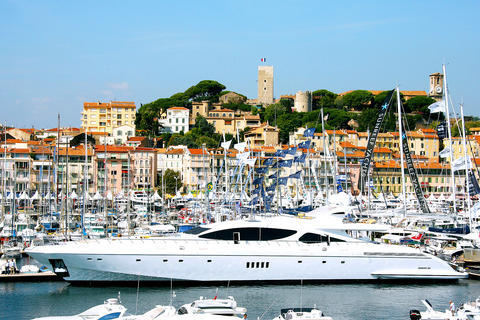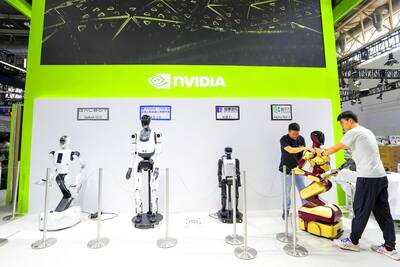Tucked away amid a mass of gleaming European and US vessels at a boat show on the French Riviera stands a lone but significant new arrival -- a powerboat made in distant Dongguan, China.
For its makers, and for a delegation of Chinese manufacturers visiting the annual "Festival de la Plaisance" pleasure boating jamboree in the chic southern resort of Cannes, this is just the beginning.
The "trawler yacht," as it is known for its similarity to a fishing trawler, is made by Selene Yachts, a Chinese manufacturer that has operated a sales outlet on the southern French coast since 2003.

PHOTO: AFP
STROLLING CANNES
As a stroll around Cannes will prove, European and US firms have the market sewn up now. French sailboat manufacturers are No. 1 in the world, while Italy dominates the market for powerboats and yachts more than 24m long.
But Chinese firms are knocking at the door.
"The quality [of Chinese boats] is identical to European and American boats but for half the price or even less," said Mark Seaton, managing director in France for Selene, who says the company sells around 20 units a year in Europe.
Alan Zhao, vice-president of Chinese yacht and motor boat maker Sunbird Yacht Co (
"Building a yacht, it's not magic, not even high-tech. It's no harder than a car," Zhao said. "We are not yet selling abroad. Our objective is to have at least one boat next year at Cannes."
NEWLY WELL-HEELED
Back home, China's newly well-heeled are only just beginning to discover pleasure boating. There are just 400 private boats registered in China, 95 percent of which are motorized.
"The development is recent because the Chinese elite only began to discover pleasure boating three of four years ago," said Delphine Lignieres, director of a marketing agency in Shanghai.
"The image of the Chinese as people who can't swim and who don't like the sun is changing progressively. Since 2004 three magazines dedicated to pleasure boating have launched in China, around 20 marinas have been created and there is at least the same amount in the works," Lignieres said.
Over the past three years, Shanghai's boat show, one of Asia's biggest, has grown sixfold in terms of area and the number of exhibitors has tripled.
And now, having stolen a march in just about every other industry, Chinese companies are setting their sights on one area where European and US firms still predominate.
"At the moment there are around 30 Chinese manufacturers that could export," Lignieres said.
But Tibor Sillinger, director of France's Federation des Industries Nautiques, is putting a brave face on the new threat and remains confident that the Europeans can stand their ground.
"The brand is a very strong idea in the water sports sector and is a strong asset for the European and French industry," he said.

UNCERTAINTIES: Exports surged 34.1% and private investment grew 7.03% to outpace expectations in the first half, although US tariffs could stall momentum The Chung-Hua Institution for Economic Research (CIER, 中華經濟研究院) yesterday raised its GDP growth forecast to 3.05 percent this year on a robust first-half performance, but warned that US tariff threats and external uncertainty could stall momentum in the second half of the year. “The first half proved exceptionally strong, allowing room for optimism,” CIER president Lien Hsien-ming (連賢明) said. “But the growth momentum may slow moving forward due to US tariffs.” The tariff threat poses definite downside risks, although the scale of the impact remains unclear given the unpredictability of US President Donald Trump’s policies, Lien said. Despite the headwinds, Taiwan is likely

When Lika Megreladze was a child, life in her native western Georgian region of Guria revolved around tea. Her mother worked for decades as a scientist at the Soviet Union’s Institute of Tea and Subtropical Crops in the village of Anaseuli, Georgia, perfecting cultivation methods for a Georgian tea industry that supplied the bulk of the vast communist state’s brews. “When I was a child, this was only my mum’s workplace. Only later I realized that it was something big,” she said. Now, the institute lies abandoned. Yellowed papers are strewn around its decaying corridors, and a statue of Soviet founder Vladimir Lenin

UNIFYING OPPOSITION: Numerous companies have registered complaints over the potential levies, bringing together rival automakers in voicing their reservations US President Donald Trump is readying plans for industry-specific tariffs to kick in alongside his country-by-country duties in two weeks, ramping up his push to reshape the US’ standing in the global trading system by penalizing purchases from abroad. Administration officials could release details of Trump’s planned 50 percent duty on copper in the days before they are set to take effect on Friday next week, a person familiar with the matter said. That is the same date Trump’s “reciprocal” levies on products from more than 100 nations are slated to begin. Trump on Tuesday said that he is likely to impose tariffs

READY TO BUY: Shortly after Nvidia announced the approval, Chinese firms scrambled to order the H20 GPUs, which the company must send to the US government for approval Nvidia Corp chief executive officer Jensen Huang (黃仁勳) late on Monday said the technology giant has won approval from US President Donald Trump’s administration to sell its advanced H20 graphics processing units (GPUs) used to develop artificial intelligence (AI) to China. The news came in a company blog post late on Monday and Huang also spoke about the coup on China’s state-run China Global Television Network in remarks shown on X. “The US government has assured Nvidia that licenses will be granted, and Nvidia hopes to start deliveries soon,” the post said. “Today, I’m announcing that the US government has approved for us